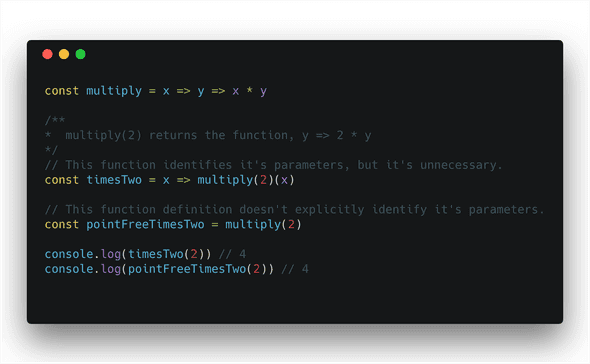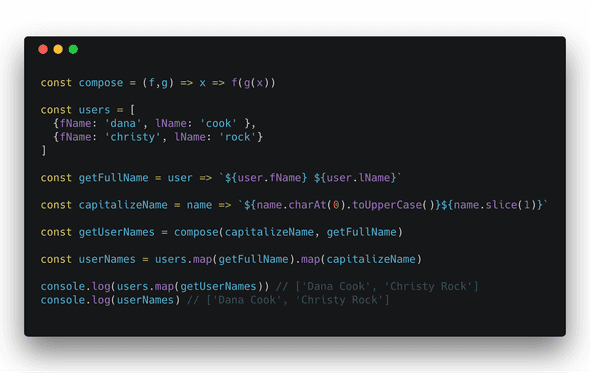Get To The Point Free
July 23, 2018
Whether it’s in software, conversation or the fifth grade - no one likes to repeat themselves.
As software developers we’re admonished against repetition and counseled instead to seek abstraction. Functional programmers are especially enamored with abstraction and have several techniques to help aid them achieve modularity.
Point free style or tacit programming is a way of defining functions that doesn’t explicitly identify it’s parameters.
What!
When I first read that definition I imagined something like this:
const greet = () => "Hello" + name
In that example, you would surely be asking yourself where the variable name came from. As name isn’t a parameter of greet it must be some global state or possibly even an undefined variable destined to crash your program. The good news is that this sort of impure code isn’t an example of tacit programming.
In reality the way we achieve point free code is that we define functions in terms of other functions. At some point down the rabbit hole there will be a function defining it’s arguments. Let’s look at some code.
code samples were made simple by using Carbon
Let it never be said that I can’t write a damned good multiply function. Damned good.
I want to direct your attention to the timesTwo function. Notice that it takes a parameter x and just calls multiply(2) with x. However, in this case the parameter x is unnecessary because multiply(2) returns a function that looks like: y => 2 * y.
So we say that timesTwo identifies it’s parameters.
What about pointFreeTimesTwo? It doesn’t explicitly tell you what it takes. However we said that multiply(2) returns a function, y => 2 * y and we define pointFreeTimesTwo to be equal to that. So we can deduce what it accepts because we know the function it is equivalent to.
In terms of utility, pointFreeTimesTwo and timesTwo are equivalent. However, by defining pointFreeTimesTwo in this way we avoid an intermediate layer of abstraction, thereby reducing redundancy. As stated above, at some point there will be one or many functions that define their arguments. You can’t have point free all the way down or no parameters would ever be defined!
Composing Right Along
Tacit programming encourages the use of composition. Leveraging composition and point free style, we can derive functions such as getUserNames.
code samples were made simple by using Carbon
Of course userNames accomplishes the same thing but the benefit of using composed functions like getUserNames we only have to iterate over the collection once!
Point Counter Point
One argument against point free style is that it is unreadable. It admittedly can be unreadable but it isn’t necessarily so. Cursive can be unreadable, but when done correctly can be elegant. In fact, tacit programming can significantly reduce complexity by preventing redundant code that only serves to obfuscate intention. If you have the benefit of working in a functional language with all the fixins then readability becomes even less of an issue with currying and composition being built in as it reduces boilerplate.
Point free style isn’t a commandment. It’s a paradigm that some people adopt early on or tend towards as they begin to lasso the chaos that comes from bloated code. If you’re a fan of terse, modular code you certainly can’t go wrong with point free style.
Hand selected musings by Thomas Manley. You may know me as that guy who sneezed once. Check out my personal site.


